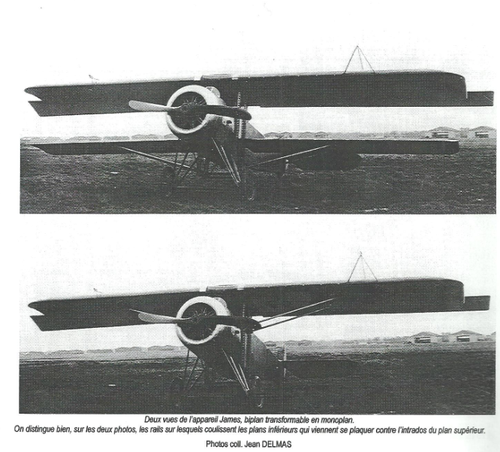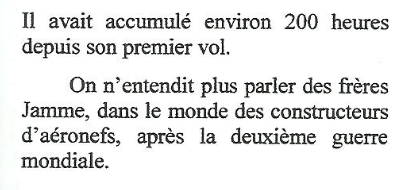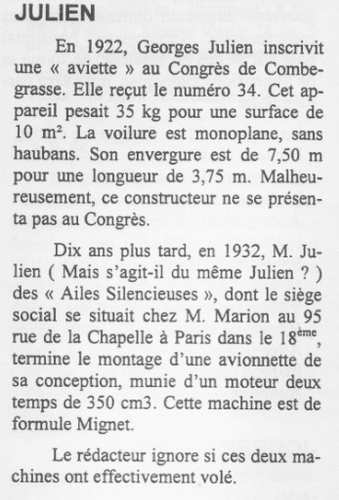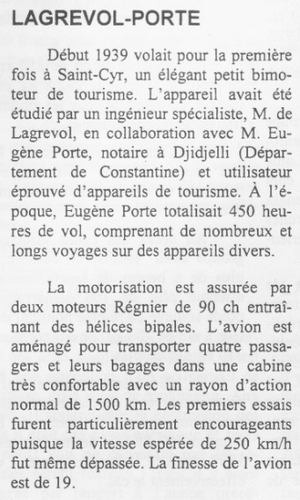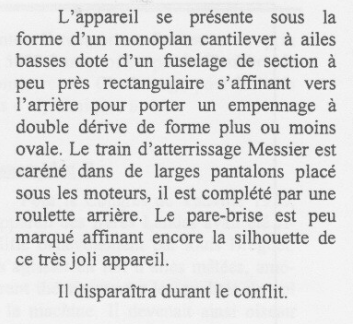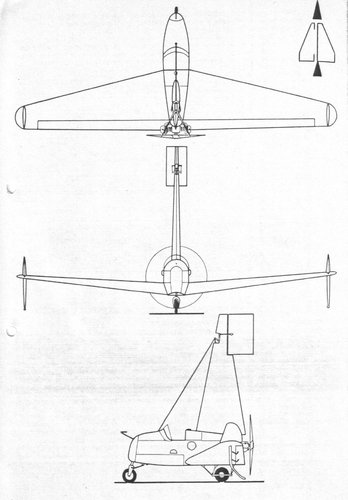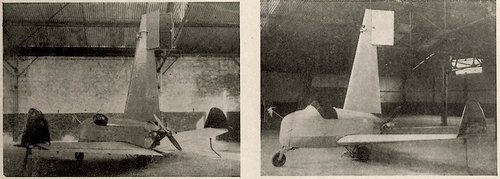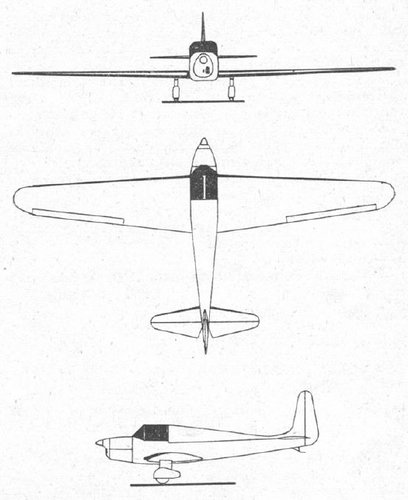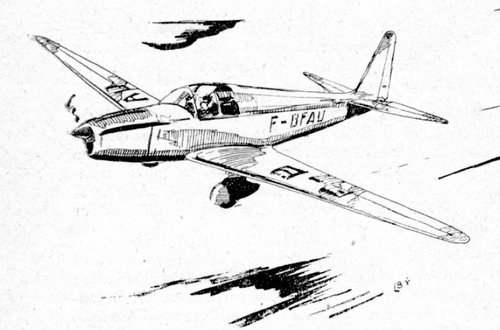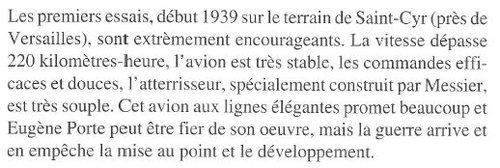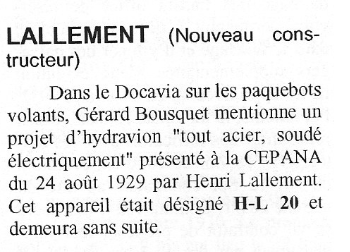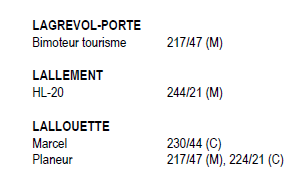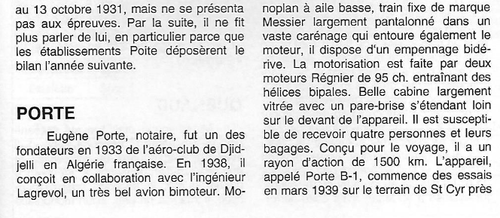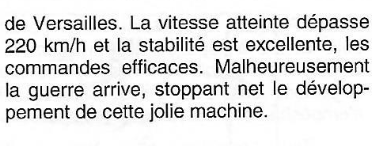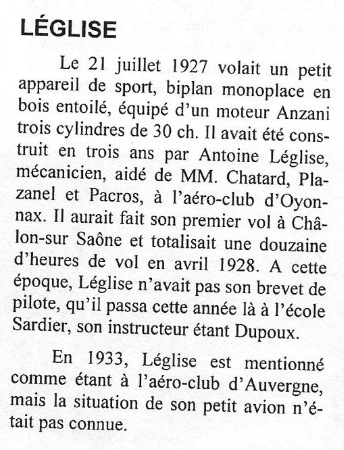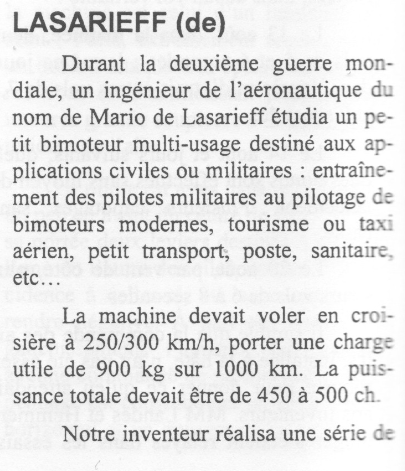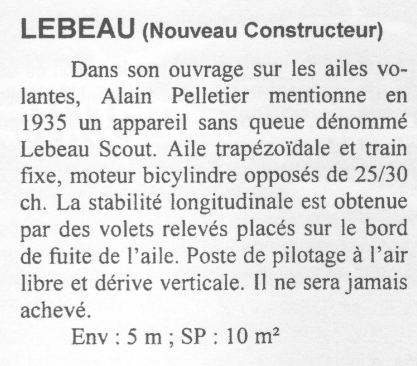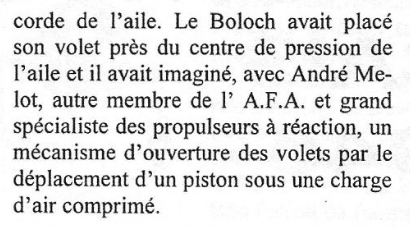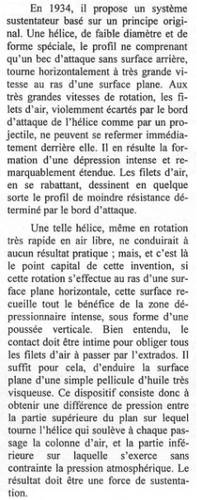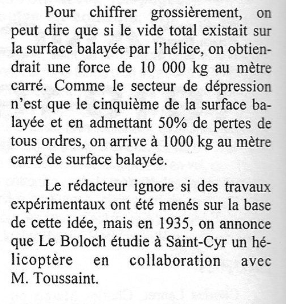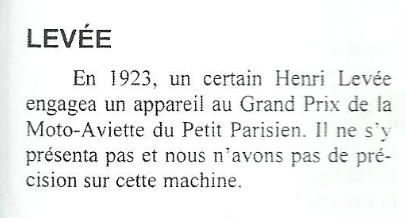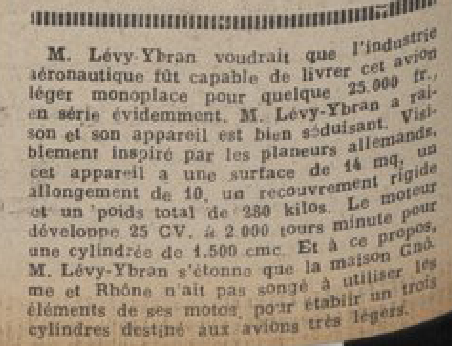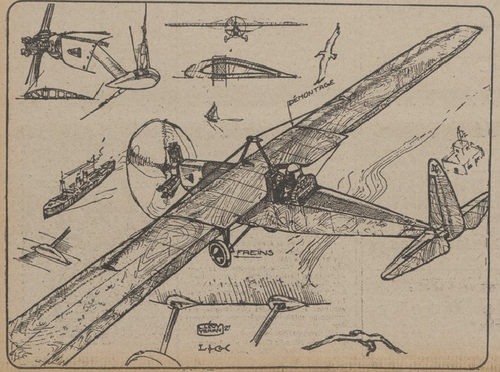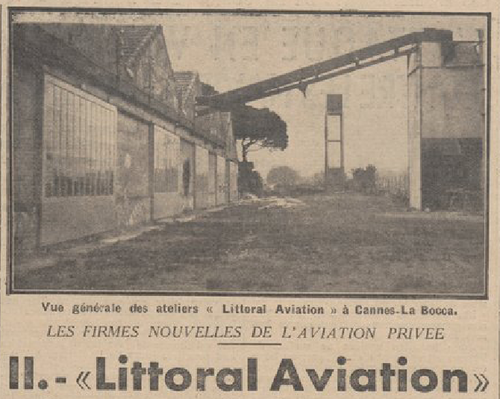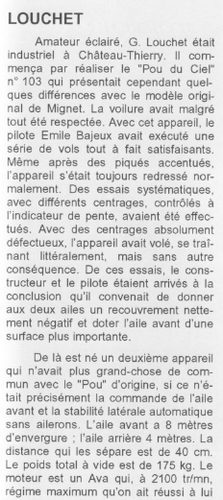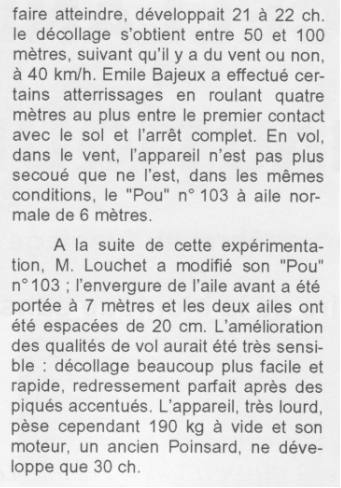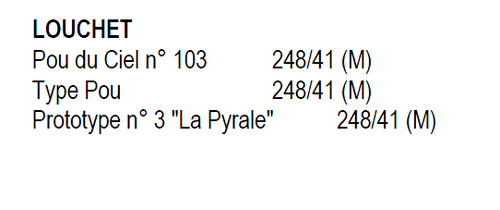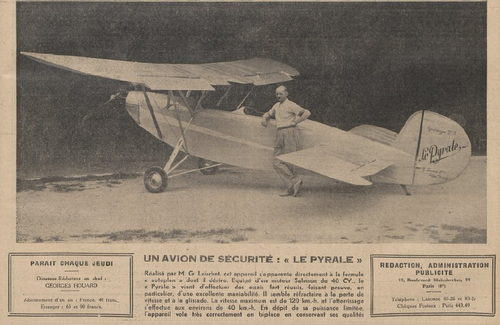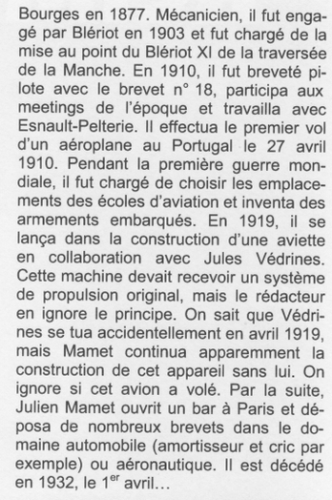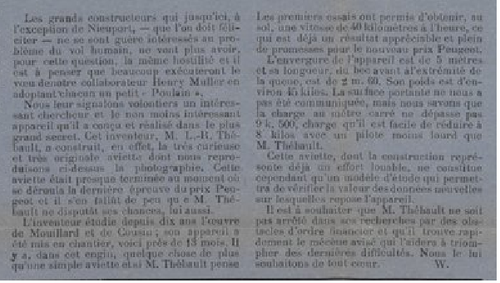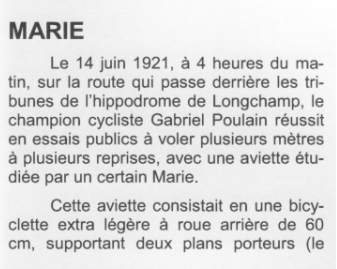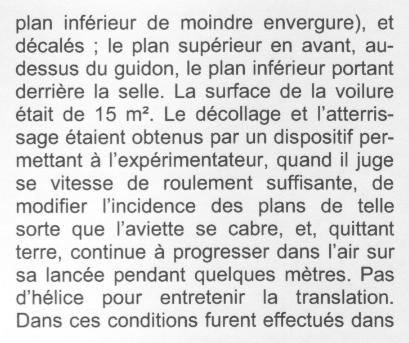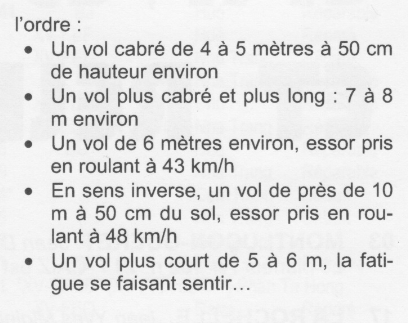You are using an out of date browser. It may not display this or other websites correctly.
You should upgrade or use an alternative browser.
You should upgrade or use an alternative browser.
Little-Known French Projects and Prototypes
- Thread starter hesham
- Start date
- Joined
- 26 May 2006
- Messages
- 34,796
- Reaction score
- 15,680
Hi Maveric,I deleted the post,and transferred it to German topic.
From TU 236,
From Mr. Huttmann,who designed a helicopter in 1927;
Bernard Bombeau points out that 1927, a certain Huttmann proposed a helicopter with tandem rotors characterized by a rear rotor more lighter than the front rotor. This characteristic would result in that,when the angle of attack increases, the two rotors rotate at different speeds. generating, according to
the inventor, longitudinal stability automatic.
From TU 236,
From Mr. Huttmann,who designed a helicopter in 1927;
Bernard Bombeau points out that 1927, a certain Huttmann proposed a helicopter with tandem rotors characterized by a rear rotor more lighter than the front rotor. This characteristic would result in that,when the angle of attack increases, the two rotors rotate at different speeds. generating, according to
the inventor, longitudinal stability automatic.
Attachments
Last edited:
- Joined
- 26 May 2006
- Messages
- 34,796
- Reaction score
- 15,680
From TU 215,
here is a Paul James biplane with could be converted into a monoplane;
In 1923, the STAe passes the market 25/3 to a man named Paul James. This market concerns a biplane
device convertible into a monoplane. The aircraft has a fixed high wing, not guyed, and one wing lower,
in fact two lower half-wings, placed on each side of the fuselage. The principle is that these two half-
wings slide vertically along rails placed against the fuselage, to come to press against the underside
of the wing su-He had accumulated about 200 hours since his first trip.
here is a Paul James biplane with could be converted into a monoplane;
In 1923, the STAe passes the market 25/3 to a man named Paul James. This market concerns a biplane
device convertible into a monoplane. The aircraft has a fixed high wing, not guyed, and one wing lower,
in fact two lower half-wings, placed on each side of the fuselage. The principle is that these two half-
wings slide vertically along rails placed against the fuselage, to come to press against the underside
of the wing su-He had accumulated about 200 hours since his first trip.
Attachments
- Joined
- 26 May 2006
- Messages
- 34,796
- Reaction score
- 15,680
From TU 216,
here is a two airplanes.designed by Georges Julien;
In 1922, Georges Julien registered an “aviette” at the Combegrasse Congress. She received number 34.
This device weighed 35 kg for an area of 10 m °. The wing is monoplane, without wire. Its wingspan is
7.50 m for a length of 3.75 m. Unfortunately, this builder did not attend Congress.
Ten years later, in 1932, Mr. Julien (But is it the same Julien?) "Silent Wings", whose headquarters social
was located at Mr. Marion's 95 rue de la Chapelle in Paris in 18 °,completes the assembly of a light aircraft
its design, equipped with a two engine time of 350 cm3. This machine is Mignet formula.
The editor does not know if these two machines actually flew.
here is a two airplanes.designed by Georges Julien;
In 1922, Georges Julien registered an “aviette” at the Combegrasse Congress. She received number 34.
This device weighed 35 kg for an area of 10 m °. The wing is monoplane, without wire. Its wingspan is
7.50 m for a length of 3.75 m. Unfortunately, this builder did not attend Congress.
Ten years later, in 1932, Mr. Julien (But is it the same Julien?) "Silent Wings", whose headquarters social
was located at Mr. Marion's 95 rue de la Chapelle in Paris in 18 °,completes the assembly of a light aircraft
its design, equipped with a two engine time of 350 cm3. This machine is Mignet formula.
The editor does not know if these two machines actually flew.
Attachments
- Joined
- 26 May 2006
- Messages
- 34,796
- Reaction score
- 15,680
Retrofit
ACCESS: Top Secret
- Joined
- 21 February 2007
- Messages
- 656
- Reaction score
- 336
From TU 217,
here is a hint about BL-10,which designed by Mr. Bouffort and Mr. Gerard Lantres in 1943.
From Le Train d'Union n°?
Attachments
Retrofit
ACCESS: Top Secret
- Joined
- 21 February 2007
- Messages
- 656
- Reaction score
- 336
This aircraft was followed by the BL-20 in 1946:
Photos of the BL-10 (unk source).
Photos of the BL-10 (unk source).
Attachments
Last edited:
Retrofit
ACCESS: Top Secret
- Joined
- 21 February 2007
- Messages
- 656
- Reaction score
- 336
I couldn't reach this site so I don't know if a 3V is presented.c460 said:Hennion light aircraft, from Les Ailes 28 Dec. 1939 and 1 Feb. 1940.
Adrien
There's more on the history of the Hennion to be found at http://forum.keypublishing.com/showthread.php?128197-The-even-newer-(2014)-Wot-plane-Quiz-Thread-Rules-In-Post-1&p=2129543#post2129543 (q.v. post #268).
Nevermind here-under 2 drawings of the aircraft designed and built by Emile Hennion ( from "Les Cahiers du RSA" n°15 July 1954).
Attachments
here is a low-wing two seat light transport monoplane,designed by Mr. de Lagrevol and Mr. Eugene Porte,
called Lagrevol-Porte Monoplane.
That looks exactly like the SETCA Petrel. Hmm.
https://www.aviafrance.com/aviafrance1.php?ID=9413&ID_CONSTRUCTEUR=347
- Joined
- 26 May 2006
- Messages
- 34,796
- Reaction score
- 15,680
That looks exactly like the SETCA Petrel. Hmm.
Oh yes,but maybe the picture only was wrong,because this SETCA was appeared in 1937,and mine was
in 1939 ?.
Retrofit
ACCESS: Top Secret
- Joined
- 21 February 2007
- Messages
- 656
- Reaction score
- 336
It is the same aircraft: When you click on Aviafrance site's icon "Plus d'histoire sur le SETCA LLP "Petrel"" you have the mention "Eugène Porte, De Lagrevol et Laboureix. Détruit dans un accident à Saint-Cyr lors des essais. ".
The right year is 1939;
Extract from the book "L'aviation légère en Algérie 1909-1939" by Pierre Jarrige, Auteur-Editeur 1992.
The right year is 1939;
Extract from the book "L'aviation légère en Algérie 1909-1939" by Pierre Jarrige, Auteur-Editeur 1992.
Attachments
Last edited:
- Joined
- 26 May 2006
- Messages
- 34,796
- Reaction score
- 15,680
From TU 244,
Mr. Henri Lallement designed a seaplane Project of 1929,called HL-20;
In the Docavia on the liners steering wheels, Gérard Bousquet mentions an all-steel, welded seaplane Project
electrically "presented to CEPANA August 24, 1929 by Henri Lallement.This device was designated HL-20 and
remained without oil.
Mr. Henri Lallement designed a seaplane Project of 1929,called HL-20;
In the Docavia on the liners steering wheels, Gérard Bousquet mentions an all-steel, welded seaplane Project
electrically "presented to CEPANA August 24, 1929 by Henri Lallement.This device was designated HL-20 and
remained without oil.
Attachments
- Joined
- 25 July 2007
- Messages
- 4,297
- Reaction score
- 4,183
Or ...
Note: The designation is H-L 20 not HL-20 (sic). That "paquebots volants" actually translates as 'flying oceanliners' so, obviously, we are talking about a very large passenger-carrying flying boat.
The Docavia publication in question is Bousquet's 2006 Les Paquebots Volants: Les hydravions français transocéaniques. Do any members have access to this book? Amazon.ca is offering me a new copy for $ 1,420.99! ;P
CEPANA, of course, refers to the Commission d'examen des Prototypes et Appareils Nouveaux de l'Aeronautique.
LALLEMENT (New manufacturer)
In the Docavia book on transoceanic flying boats, Gérard Bousquet mentions a seaplane project "of all electrically-welded steel construction," present to CEPANA on 24 August 1929 by Henri Lallement. This aircraft was designated H-L 20 but the project was not pursued.
Note: The designation is H-L 20 not HL-20 (sic). That "paquebots volants" actually translates as 'flying oceanliners' so, obviously, we are talking about a very large passenger-carrying flying boat.
The Docavia publication in question is Bousquet's 2006 Les Paquebots Volants: Les hydravions français transocéaniques. Do any members have access to this book? Amazon.ca is offering me a new copy for $ 1,420.99! ;P
CEPANA, of course, refers to the Commission d'examen des Prototypes et Appareils Nouveaux de l'Aeronautique.
- Joined
- 26 May 2006
- Messages
- 34,796
- Reaction score
- 15,680
It is the same aircraft: When you click on Aviafrance site's icon "Plus d'histoire sur le SETCA LLP "Petrel"" you have the mention "Eugène Porte, De Lagrevol et Laboureix. Détruit dans un accident à Saint-Cyr lors des essais. ".
The right year is 1939;
A confirm from TU 277.
Attachments
- Joined
- 26 May 2006
- Messages
- 34,796
- Reaction score
- 15,680
From TU 226,
here is a biplane,designed by Mr. Antoine Léglise;
July 21, 1927 designed a small sports device, single seat biplane canvas wood, fitted with an Anzani motor
three cylinders of 30 hp. It had been built in three years by Antoine Léglise,mechanic, assisted by MM. Chatard,
Plazanel and Pacros, at the Oyonnax flying club. It would have made its first flight to Chàlon-sur Saône and
totaled a dozen hours of flight in April 1928. At this at the time, Léglise did not have his patent pilot, whom
he spent that year at Pécole Sardier, his instructor being Dupoux.
In 1933, Léglise is mentioned as being at the flying club of Auvergne, but the whereabouts of his small plane
were unknown.
here is a biplane,designed by Mr. Antoine Léglise;
July 21, 1927 designed a small sports device, single seat biplane canvas wood, fitted with an Anzani motor
three cylinders of 30 hp. It had been built in three years by Antoine Léglise,mechanic, assisted by MM. Chatard,
Plazanel and Pacros, at the Oyonnax flying club. It would have made its first flight to Chàlon-sur Saône and
totaled a dozen hours of flight in April 1928. At this at the time, Léglise did not have his patent pilot, whom
he spent that year at Pécole Sardier, his instructor being Dupoux.
In 1933, Léglise is mentioned as being at the flying club of Auvergne, but the whereabouts of his small plane
were unknown.
Attachments
- Joined
- 26 May 2006
- Messages
- 34,796
- Reaction score
- 15,680
From TU 217,
Mr. Mario de Lasarieff designed a low-wing twin engined light transport,crew trainer,liaison,tourist and
postal monoplane Project,powered by either two 220 to 250 hp engines.
I remember we spoke about this airplane before ?.
Mr. Mario de Lasarieff designed a low-wing twin engined light transport,crew trainer,liaison,tourist and
postal monoplane Project,powered by either two 220 to 250 hp engines.
I remember we spoke about this airplane before ?.
Attachments
- Joined
- 26 May 2006
- Messages
- 34,796
- Reaction score
- 15,680
From TU 230,
Mr. Lebeau designed a flying wing tailless light airplane,called Scout;
In his work on flying wings, Alain Pelletier mentions in 1935 a tailless airplane called Lebeau Scout,trapezoidal
wing and train fixed, 25/30 hp opposing twin-cylinder engine,longitudinal stability is obtained by raised flaps
placed on the edge wing leak,cockpit in the air free and vertical drift,it was never completed.
Length 5 m ; SP: 10 m °
Mr. Lebeau designed a flying wing tailless light airplane,called Scout;
In his work on flying wings, Alain Pelletier mentions in 1935 a tailless airplane called Lebeau Scout,trapezoidal
wing and train fixed, 25/30 hp opposing twin-cylinder engine,longitudinal stability is obtained by raised flaps
placed on the edge wing leak,cockpit in the air free and vertical drift,it was never completed.
Length 5 m ; SP: 10 m °
Attachments
- Joined
- 26 May 2006
- Messages
- 34,796
- Reaction score
- 15,680
From TU 226,
Mr. Henri Le Boloch designed a system for Brake Flaps in 1920,followed by Lift Machine with a propellers,and
a Helicopter in 1934/35,we spoke about him before here;
The first is the subject of the patent 526,166 filed February 20, 1920 and which relates to lower shutters, in fact
brake flaps.
In 1934, he proposed a system lift based on an original principle. A small diameter propeller special shape, the
profile not including than an attack spout with no back surface,rotates horizontally at very high speed flush with
a flat surface. To the very high rotational speeds, the air streams, violently spread by the edge of the propeller
as by a projectile, cannot close immediately behind her. The result is the formation of an intense and remarkably extensive depression. Air nets,by folding back, draw in some so the profile of least resistance determined by the
leading edge.
Such a propeller, even in rotation very fast in the open air, would not lead to no practical results; but, and there it
is the crux of this invention, if this rotation takes place flush with a horizontal plane surface, this surface harvest all
the benefit of the area intense pressure, in the form of a vertical thrust. Of course, the contact must be intimate to compel all the air streams to pass through the upper surface.,it suffices to coat the surface plane with a simple film
of oil very viscous,this device therefore consists of get a pressure difference between the upper part of the plane on which turns the propeller which lifts the column of air at each pass, and the lower part on which is exerted without
constrains atmospheric pressure. The result must be a lifting force.
To roughly quantify, we can say that if the total vacuum existed on the surface swept by the propeller, we would
obtain a force of 10,000 kg per meter square. Like the depression area is only one fifth of the swept area and
admitting 50% of all orders, we arrive at 1000 kg per meter square of swept area.
Editor does not know if work were conducted on the basis of this idea, but in 1935, it was announced that Le Boloch
is studying a helicopter at Saint-Cyr in collaboration with Mr. Toussaint.
Mr. Henri Le Boloch designed a system for Brake Flaps in 1920,followed by Lift Machine with a propellers,and
a Helicopter in 1934/35,we spoke about him before here;
The first is the subject of the patent 526,166 filed February 20, 1920 and which relates to lower shutters, in fact
brake flaps.
In 1934, he proposed a system lift based on an original principle. A small diameter propeller special shape, the
profile not including than an attack spout with no back surface,rotates horizontally at very high speed flush with
a flat surface. To the very high rotational speeds, the air streams, violently spread by the edge of the propeller
as by a projectile, cannot close immediately behind her. The result is the formation of an intense and remarkably extensive depression. Air nets,by folding back, draw in some so the profile of least resistance determined by the
leading edge.
Such a propeller, even in rotation very fast in the open air, would not lead to no practical results; but, and there it
is the crux of this invention, if this rotation takes place flush with a horizontal plane surface, this surface harvest all
the benefit of the area intense pressure, in the form of a vertical thrust. Of course, the contact must be intimate to compel all the air streams to pass through the upper surface.,it suffices to coat the surface plane with a simple film
of oil very viscous,this device therefore consists of get a pressure difference between the upper part of the plane on which turns the propeller which lifts the column of air at each pass, and the lower part on which is exerted without
constrains atmospheric pressure. The result must be a lifting force.
To roughly quantify, we can say that if the total vacuum existed on the surface swept by the propeller, we would
obtain a force of 10,000 kg per meter square. Like the depression area is only one fifth of the swept area and
admitting 50% of all orders, we arrive at 1000 kg per meter square of swept area.
Editor does not know if work were conducted on the basis of this idea, but in 1935, it was announced that Le Boloch
is studying a helicopter at Saint-Cyr in collaboration with Mr. Toussaint.
Attachments
- Joined
- 26 May 2006
- Messages
- 34,796
- Reaction score
- 15,680
Hi,
does anyone know those two designers and their airplanes,Leroy GL.1 and Le Sech two-seat ?,and
was this person which they meant or not ?.
does anyone know those two designers and their airplanes,Leroy GL.1 and Le Sech two-seat ?,and
was this person which they meant or not ?.
Attachments
Last edited:
The little quote says he never showed up at the contest, so nothing more is known about the plane, and I didn't turn up anything either. Not what you asked for, but here is a contemporary article from LES AILES describing the contest and some of the planes that did show up. There is also a contemporary article in English if anyone has an AVIATION WEEK online subscription: https://archive.aviationweek.com/issue/19230820
Mr. Henri Levee designed a ultra-light airplane in 1923,no more details are known ?.
Attachments
- Joined
- 26 May 2006
- Messages
- 34,796
- Reaction score
- 15,680
From TU 229,and Ailes 1929 & 1932,
Mr. Lévy-Ybran designed a single seat light Monoplane;
In 1929, Mr. Lévy-Ybran proposed a long-elongated, single-seat tourism unit for 25,000 francs,it
had a surface of 14 m2, an elongation of 10, a rigid covering and a total weight of 280 kg,the engine
develops 25 hp. at 2000 revs for a displacement of 1500 cm °.
I don't know if he was the same Georges Levy or not ?.
Mr. Lévy-Ybran designed a single seat light Monoplane;
In 1929, Mr. Lévy-Ybran proposed a long-elongated, single-seat tourism unit for 25,000 francs,it
had a surface of 14 m2, an elongation of 10, a rigid covering and a total weight of 280 kg,the engine
develops 25 hp. at 2000 revs for a displacement of 1500 cm °.
I don't know if he was the same Georges Levy or not ?.
Attachments
- Joined
- 26 May 2006
- Messages
- 34,796
- Reaction score
- 15,680
From TU 226,
here is the Le Grix,which I spoke about it before;
941 a program was drawn up of gliders to equip the French gliding centers. A total 363 gliders were to be available, requiring the construction of new aircraft. These new devices were to be built by eight companies, among which the Société d'Atude et de Construction Aéronavale Le Grix in Marseille.
He was scheduled to order 30 AVIA 152 A and two prototype gliders The Grix. But in 1943, only the 30 AVIA 152 À
were still on order. It is assumed that the two prototypes were abandoned because there was never any mention of
an any Le Grix glider.
The editor is unaware of any of these glider projects.
here is the Le Grix,which I spoke about it before;
941 a program was drawn up of gliders to equip the French gliding centers. A total 363 gliders were to be available, requiring the construction of new aircraft. These new devices were to be built by eight companies, among which the Société d'Atude et de Construction Aéronavale Le Grix in Marseille.
He was scheduled to order 30 AVIA 152 A and two prototype gliders The Grix. But in 1943, only the 30 AVIA 152 À
were still on order. It is assumed that the two prototypes were abandoned because there was never any mention of
an any Le Grix glider.
The editor is unaware of any of these glider projects.
Attachments
- Joined
- 25 July 2007
- Messages
- 4,297
- Reaction score
- 4,183
what was this; Littoral Aviation E.111 ?.
In 1938, the Canne woodworking firm of Le Comptoir du Littoral created an aviation department named - rather unimaginatively - the Département Aviation. On 01 Jan. 1939, that department was redubbed Littoral Aviation. The E-111 was Littoral's 2-seat aerobatics trainer aimed at the French military use. The prototype flew on 08 April 1939 (piloted by Edward Bret) with an airworthiness certificate (CN) received on 06 July 1939. Alas, performance was deemed inadequate and work on the E-111 was abandoned.
According to Edward Bret (1907-1996), pilote d’exception by Philippe Jung, the appearance of the sole E-111 was unknown until a photograph (attached) was found in the archives of Edward Bret ("Aucune photo de ce mystérieux avion n’était connue des historiens, jusqu’à ce qu’elle soit trouvée dans les archives d’Edward.")
Attachments
- Joined
- 26 May 2006
- Messages
- 34,796
- Reaction score
- 15,680
- Joined
- 25 July 2007
- Messages
- 4,297
- Reaction score
- 4,183
here is a Helicoplane,designed by Mr. Mallet.
Something like ...
Someone named Mallet - who had been studying the problem of the helicopter since 1908 - manufacturing many scale models to test his ideas. Between the two wars, Mallet proposed a vertical takeoff aircraft called the Hélicoplan. This machine, the concept of which was supported by the son of Léon Levavasseur, was in the form of a canard aircraft. Each half of the rear wing carried a variable-pitch propeller, the pilot being able to change its incidence in azimuth in flight (according to a 1915 patent from Levavasseur and Gastambide). The empennage was located at the front of the fuselage.
This aircraft was to land vertically on its tail wheels. It would take off vertically and then transitioned to forward flight as a conventional aircraft - albeit a canard. Mallet and Lavavasseur produced a scale model of 1.50 m wingspan of the helicoplane, a model which (according to Levavasseur) gave full satisfaction, although it took much trial-and-error before arriving there. No full-sized aircraft was realized.
This M. Mallet could be anyone. Might that include the famous aeronaut, Maurice Mallet? That Mallet was a balloon- (Société Mallet, Mélandri et de Pitray) and aircraft-maker (Zodiac) as well as an Aéro-Club de France co-founder. Could it be the same person?
If I got the translation right, the Levavasseur in question was the son (fils) of Léon Levavasseur. But then there is mention of "un brevet Levavasseur et Gastambide datant de 1915." Now I'm confused. Jules Gastambide was the money backing ingénieur Léon Levavasseur. So, that 1915 patent would seem to have been made in the names of these two partners - not Léon's son
Possibly more info here? L'Hélicoplane Mallet-Levavasseur, L'Air, Paris, Sept. 1, 1929, v.11, no.236, p.17, diagrs.
- Joined
- 26 May 2006
- Messages
- 34,796
- Reaction score
- 15,680
What was this ?,a Peugeot design ?.
Attachments
richard B
ACCESS: Secret
- Joined
- 17 August 2006
- Messages
- 343
- Reaction score
- 498
Monsieur L.R.Thébault is the designer and builder of this bird .What was this ?,a Peugeot design ?.
http://www.theaerodrome.com/forum/showthread.php?t=64156
- Joined
- 25 July 2007
- Messages
- 4,297
- Reaction score
- 4,183
here is a biplane,designed by Mr. Antoine Léglise; ...
I found a bit of bio on Antoine Léglise (in two chunks) here:
Aéroclub Jean Coutty - Oyonnax (Ain)
Aéroclub Jean Coutty - Oyonnax (Ain)
LEGLISE, Antoine, was born on 27 October 1904 in Chalon-sur-Saône [in eastern France]. He left his studies without a baccalauréat, becoming an apprentice mechanic at the Compagnie Française d’Aviation on the airfield of Chalon-sur-Saône in 1922.
Subsequently, he continued in airplane mechanics at Toussus-le-Noble [Île-de-France], then at Villacoublay with Morane Saulnier. Over three years - from 1923 to 1927, outside of working hours - Léglise used his salary to fund the contruction of a small passenger plane powered by a 30 hp Anzani engine.
This aircraft was built by hand in the Léglise family home on rue Greuze in Chalon. The aircraft was then transported to the home of a friend in nearby Crissey for testing and its maiden flight. Having only completed 3.5 hours of dual-control ground training at Buc, this 21 July 1927 maiden flight was also Léglise's first first solo.
At the Châlon aerodrome where his plane landed, he continued his 10-hour flight to obtain his pilot's license. In 1928, while Antoine Léglise worked at the Compagnie Française d'Aviation in Aulnat, he passed his private pilot's license (No. 0344) on 04 October 1928 and his commercial pilot's license (No. 1261) on 15 January 1930. He obtained his military pilot's license (No. 22389) on 15 March 1929 during a military stint in Dijon-Longvic. Antoine Léglise began his professional career as an instructor pilot at Aulnat at the Aéroclub d'Auvergne from 01 March 1928 to 01 December 1933.
It was then that he bought Morane AS, F-ABHD - a single-seat aerobatic aircraft - with which he participated in meetings. In early 1935, Léglise, Sordet and Goudard were the first to land on the brand new airfield at Châlon-Champforgeuil.
He was chief pilot at the Aéroclub de Bourgogne in Châlon-sur-Saône from 01 January 1934 to 15 June 1935, then instructor at the Caudron d'Ambérieu en Bugey School from 20 June 1935 to 01 October 1936. From 15 December 1936 to 01 October 1939, he was chief pilot at the Section d’Aviation Populaire of the Aéroclub de Lons le Saunier.
At the start of the Second World War, from October 26, 1939 to July 14, 1940, he was mobilized as a non-commissioned flight instructor at Ecole de pilotage n° 44 in Saint Etienne Bouthéon, then at the Ecole de moniteurs de Salon in Provence, where he flew 312 hours.
Antoine Léglise did a gliding course at the Centre de La Montagne Noire from October to December 1941. During the occupation, he found work in the undercarriage design office at Breguet in Toulouse under the direction of Pierre Satre. In the aftermath of the war, he worked at the Atelier Industriel Aéronautique [AIA] at Clermont-Ferrand [in central France] from 15 January 1945 to 23 January 1946.
From 01 February 1946 to 01 January 1954, Antoine Léglise was chief pilot and instructor pilot at the Aéroclub de Lons-le-Saulnier [in eastern France]. On this aerodrome, from 01 January 1954 to 31 December 1959, he held the position of manager of the Coopérative de Construction et de Réparation de Matériel Aéronautique (CCRMA), acceptance and test pilot of repaired and homebuilt airplanes and gliders (some Jodel D 11 were built, including the F-BHDD for the Aéroclub de Bourgogne), from 01 January 1960 to 31 October 1961, he was technical director, monitor, and test pilot for the Société de Construction de Matériel aéronautique (SOCOMA).
Antoine Léglise had the capacities of an engineer, he built the L 400 two-seater 'Bambi' (F-PJCK, first flight 22 May 1959 at Lons-le-Saulnier); the 4-seat, 4-door, 150 hp L 500 'Jumbo' (F-WJSC, first flight 27 February 1961 at Lons-le-Saulnier)...; half a dozen wing set for the L 600 'Mowgli' - a 3-seat version of the L 400 - were abandoned when 50% complete (the result of financial problems which caused the closure of the workshop at the end of 1961)...
Before it closed, SOCOMA had also built two steel-tube fuselages for Sepal 01s on behalf of SCINTEX, which then abandoned this project.
Antoine Léglise projects were: a 2-seat tandem aircraft with low wing which resulted in only a wind tunnel model and a 1931/32 test file (entitled Avion Léglise n° 2) from the Laboratoire Eiffel; a four-seat retractable undercarriage type inspired by the [Caudron] Simoun; complete files, calculations and plans, of lightweight versions of the L 500 and L 700, and a metal-construction version, the L 800; a draft of a tandem two-seater aerobatic plane; as well as a jet-propelled tandem airplane fitted with a Turboméca turbojet.
From 01 November 1961 to 31 December 1965, Antoine Léglise was an instructor pilot at the Société Oyonnaxienne des Sports Aériens (SOSA, which will later become the Aéroclub Jean Coutty); he was at the Aéroclub Belley in 1966; the Aéroclub de la Creuse in Guéret in the summer of 1967; the Aéroclub du Blanc in the summer of 1968; and the Aéroclub Plessis-Belleville from October 1968 to May 1972. In 1947, Antoine Léglise published a work entitled La Normalisation des Méthodes d’Instruction au Pilotage des Avions ('The Standardization of Instruction Methods for Piloting Airplanes') with a preface by Georges Détré. In 1972, Léglise published another fairly critical work, entitled Adieu Pilotage, and in 1977 Initiation critique et sulfureuse à la science économique [an economics work].
Awarded the Médaille de l’Aéronautique on 19 September 1949, Antoine Léglise retired to Rully and became a simple member of the Aéroclub Beaunois as a private pilot with a total of 7,405 flying hours. Antoine Léglise died in Châlon-sur Sâone on 20 March 1989 and was buried in Rully (Sâone et Loire).
- Joined
- 26 May 2006
- Messages
- 34,796
- Reaction score
- 15,680
From TU 263;
the Marie Aviette
On June 14, 1921, at 4 a.m., on the road that passes behind the stands of the Longchamp racecourse, the
cycling champion Gabriel Poulain succeeds
in public trials to fly several meters
on several occasions, with an aviette studied by a certain Marie.
This aviette consisted of an extra light rear wheel bicycle of 60
cm, supporting two load-bearing planes (the
smaller lower plan), and
staggered; the upper plane forward, above the handlebars, the lower plane bearing
behind the saddle. The surface of the wing
was 15 m2. Take-off and landing were obtained by a device allowing the experimenter, when he judges
sufficient rolling speed,
change the impact of plans such
so that the plate rears up, and, leaving
earth, continues to progress in the air on
its launched for a few meters. Not
propeller to maintain the translation.
Under these conditions were carried out in
the order:
- A nose-up flight from 4 to 5 meters to 50 cm
about height
- A more nose-up and longer flight: 7 to 8
m approximately
- A flight of about 6 meters, boom taken
when traveling at 43 km / h
- An opposite direction, a flight of almost 10
m at 50 cm from the ground, boom taken at 48 km / h
- A shorter flight of 5 to 6 m, fatigue being felt.
the Marie Aviette
On June 14, 1921, at 4 a.m., on the road that passes behind the stands of the Longchamp racecourse, the
cycling champion Gabriel Poulain succeeds
in public trials to fly several meters
on several occasions, with an aviette studied by a certain Marie.
This aviette consisted of an extra light rear wheel bicycle of 60
cm, supporting two load-bearing planes (the
smaller lower plan), and
staggered; the upper plane forward, above the handlebars, the lower plane bearing
behind the saddle. The surface of the wing
was 15 m2. Take-off and landing were obtained by a device allowing the experimenter, when he judges
sufficient rolling speed,
change the impact of plans such
so that the plate rears up, and, leaving
earth, continues to progress in the air on
its launched for a few meters. Not
propeller to maintain the translation.
Under these conditions were carried out in
the order:
- A nose-up flight from 4 to 5 meters to 50 cm
about height
- A more nose-up and longer flight: 7 to 8
m approximately
- A flight of about 6 meters, boom taken
when traveling at 43 km / h
- An opposite direction, a flight of almost 10
m at 50 cm from the ground, boom taken at 48 km / h
- A shorter flight of 5 to 6 m, fatigue being felt.
Attachments
- Joined
- 26 May 2006
- Messages
- 34,796
- Reaction score
- 15,680
From TU 264,
Massiera & Bruno;
In the 1930s, two Parisian taxi drivers, MM Massiera and
Bruno, manufactured a pedal Helicopter called "La Girouette". The device was
actually a bike that had been faired and endowed
rear tail. The two-bladed rotor
rested above the cyclist’s head,
carried by a tubular structure. it was
driven by the rear wheel. The device
did not have an anti-torque rotor. We
easily imagine the results of the experiment
Massiera & Bruno;
In the 1930s, two Parisian taxi drivers, MM Massiera and
Bruno, manufactured a pedal Helicopter called "La Girouette". The device was
actually a bike that had been faired and endowed
rear tail. The two-bladed rotor
rested above the cyclist’s head,
carried by a tubular structure. it was
driven by the rear wheel. The device
did not have an anti-torque rotor. We
easily imagine the results of the experiment
Attachments
avion ancien
The accidental peasant!
- Joined
- 6 March 2013
- Messages
- 371
- Reaction score
- 251
I'd imagine that la girouette described its performance perfectly - except, no doubt, it wouldn't have required the wind to rotate it as it would have achieved that by its own efforts!
Similar threads
-
-
Arsenal de l'aéronautique: built prototypes and unbuilt projects
- Started by Jemiba
- Replies: 96
-
-
Various SNCASO (Sud-Ouest) Projects and Prototypes
- Started by hesham
- Replies: 26
-


